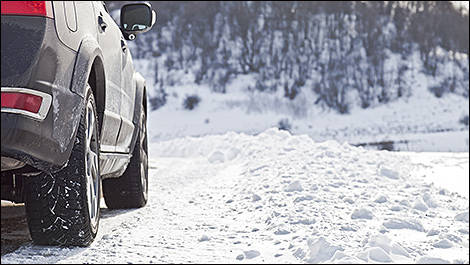Notice the leaves turning and starting to fall? This means the winter season is just around the bend. Like it or not, it is already time to seriously start thinking about getting some winter tires.
There are plenty of things to think about when shopping for these large rubber winter-ready doughnuts, so we put this quick winter tire-buying checklist together to help you along with your selection.
Type of vehicle
Passenger cars, CUVs and minivans, performance cars, and trucks are the principal segments of motor vehicles catered to by tire manufacturers. Each category of vehicle requires a specific tire type with the proper speed and load ratings. These details and specifications are very important to consider.
In most cases, your tire retailer will only recommend the proper tire for your vehicle. The tire's sidewalls contain all of these vital pieces of information (including size), but once again, you should not have to worry about these details.
Type of conditions
There are two types of road conditions to consider (and they come in a number of variations): ice and snow. For most urbanites, navigating plowed city streets and highways does not require hardcore snow tires. In fact, ice tires (which can also manage snow quite well) are a better choice, especially when we remember slippery intersections with stop signs.
Those who live in a more rural setting should consider snow tires for the opposite reason. Their best bet is likely a set of studded snow tires, for both ice and snow.
Driving requirements
This pertains to the actual type of driving you do and will do during the winter season. Many of us park - sorry -- cover ground on highways at speeds. For this reason, it could be wise to look into a performance winter tire that will remain stable at higher rates of speed. This can apply to both cars and many crossover vehicles.
Alternatively, tires with deeper tread blocks are better suited for snow and slush accumulation as they can properly evacuate what stands between the tire and the road's surface. These same tires can be the cause of a loss of steering responsiveness and overall stability at higher speeds.
4-season and the snowflake
The splicing of the winter-tire gene with that of the 4-season tire gene is becoming an increasingly common practice. So much so that the all-important, all-encompassing snowflake and mountain logo can be found on tires that, not so long ago, would not have been considered worthy.
Compound compositions have evolved vastly over the last few years to bring us closer to a single tire with the ability to handle multiple driving conditions. By definition though, these tires remain a compromise. The ideal solution for most of the Canadian market is to own two sets of tires, one for warmer days and one for when the temperature drops.
Tread wear
Different depths of tread have an influence on many facets of the tire's performance. The first is longevity or how long a tire will be able to "function" properly in the conditions for which it was designed.
Most true winter tires for cars will offer between 11/32 and 13/32 of tread depth. The deeper they are, the more apt the tire is at clearing the space sandwiched between the tire's contact patch and the road. Some provide shorter tread blocks with little compromise thanks to their innovative and technologically advanced tread design.
The final word: Price.
The bottom line is and will always be that you get what you pay for. Thankfully, tire pricing has dropped making tires more affordable.
Even so, you cannot expect a $75 tire to perform as well or for as long as a $125 tire in an equivalent size. Check out our recommendations for both cars and CUV/Minivan/small SUV.
There are plenty of things to think about when shopping for these large rubber winter-ready doughnuts, so we put this quick winter tire-buying checklist together to help you along with your selection.
Type of vehicle
Passenger cars, CUVs and minivans, performance cars, and trucks are the principal segments of motor vehicles catered to by tire manufacturers. Each category of vehicle requires a specific tire type with the proper speed and load ratings. These details and specifications are very important to consider.
In most cases, your tire retailer will only recommend the proper tire for your vehicle. The tire's sidewalls contain all of these vital pieces of information (including size), but once again, you should not have to worry about these details.
 |
Type of conditions
There are two types of road conditions to consider (and they come in a number of variations): ice and snow. For most urbanites, navigating plowed city streets and highways does not require hardcore snow tires. In fact, ice tires (which can also manage snow quite well) are a better choice, especially when we remember slippery intersections with stop signs.
Those who live in a more rural setting should consider snow tires for the opposite reason. Their best bet is likely a set of studded snow tires, for both ice and snow.
Driving requirements
This pertains to the actual type of driving you do and will do during the winter season. Many of us park - sorry -- cover ground on highways at speeds. For this reason, it could be wise to look into a performance winter tire that will remain stable at higher rates of speed. This can apply to both cars and many crossover vehicles.
Alternatively, tires with deeper tread blocks are better suited for snow and slush accumulation as they can properly evacuate what stands between the tire and the road's surface. These same tires can be the cause of a loss of steering responsiveness and overall stability at higher speeds.
4-season and the snowflake
The splicing of the winter-tire gene with that of the 4-season tire gene is becoming an increasingly common practice. So much so that the all-important, all-encompassing snowflake and mountain logo can be found on tires that, not so long ago, would not have been considered worthy.
Compound compositions have evolved vastly over the last few years to bring us closer to a single tire with the ability to handle multiple driving conditions. By definition though, these tires remain a compromise. The ideal solution for most of the Canadian market is to own two sets of tires, one for warmer days and one for when the temperature drops.
Tread wear
Different depths of tread have an influence on many facets of the tire's performance. The first is longevity or how long a tire will be able to "function" properly in the conditions for which it was designed.
Most true winter tires for cars will offer between 11/32 and 13/32 of tread depth. The deeper they are, the more apt the tire is at clearing the space sandwiched between the tire's contact patch and the road. Some provide shorter tread blocks with little compromise thanks to their innovative and technologically advanced tread design.
The final word: Price.
The bottom line is and will always be that you get what you pay for. Thankfully, tire pricing has dropped making tires more affordable.
Even so, you cannot expect a $75 tire to perform as well or for as long as a $125 tire in an equivalent size. Check out our recommendations for both cars and CUV/Minivan/small SUV.
Read more on the subject
|



